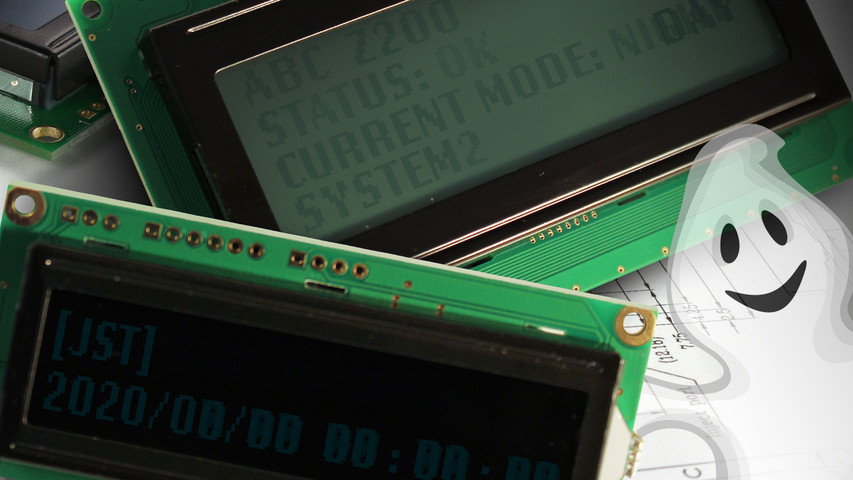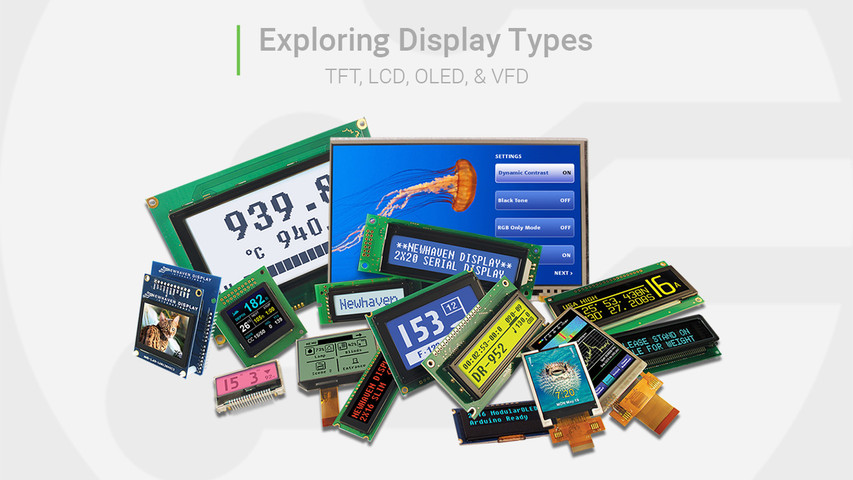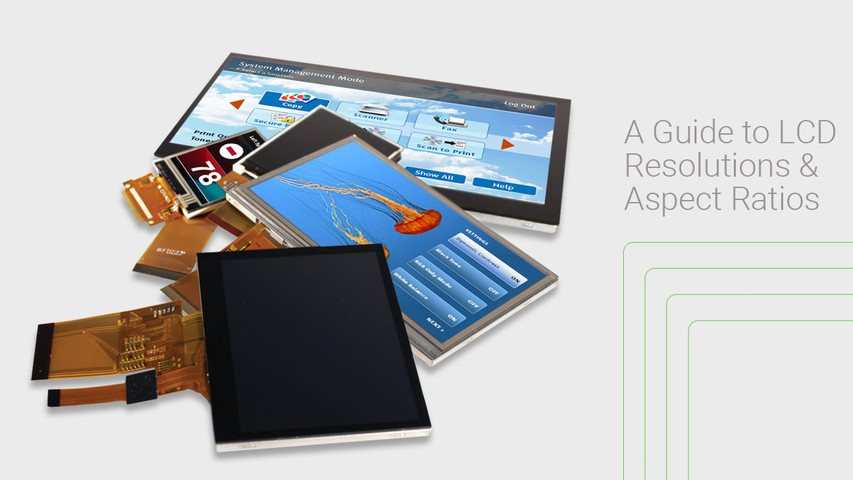Screen Burn-In
Image burn-in affects all screen displays, including LCDs and OLEDs in mobile phones, monitors, wearable devices, televisions, and all electronic devices with a display screen. This article will cover everything you need to know about image burn-in and ways to mitigate it.
Eis o que vai aprender neste post:
What is Screen Burn-in?
Screen burn, also known as burn-in, occurs when a persistent image leaves a permanent ghost-like imprint on a display. While this issue is most commonly associated with OLED (Organic Light-Emitting Diode) displays, LCDs (Liquid Crystal Displays) can also experience a form of temporary image retention called image persistence. Understanding how different display technologies respond to prolonged static images is crucial for engineers designing applications in industrial, medical, and commercial environments.
Relacionado: O que é a descarga electrostática (ESD)
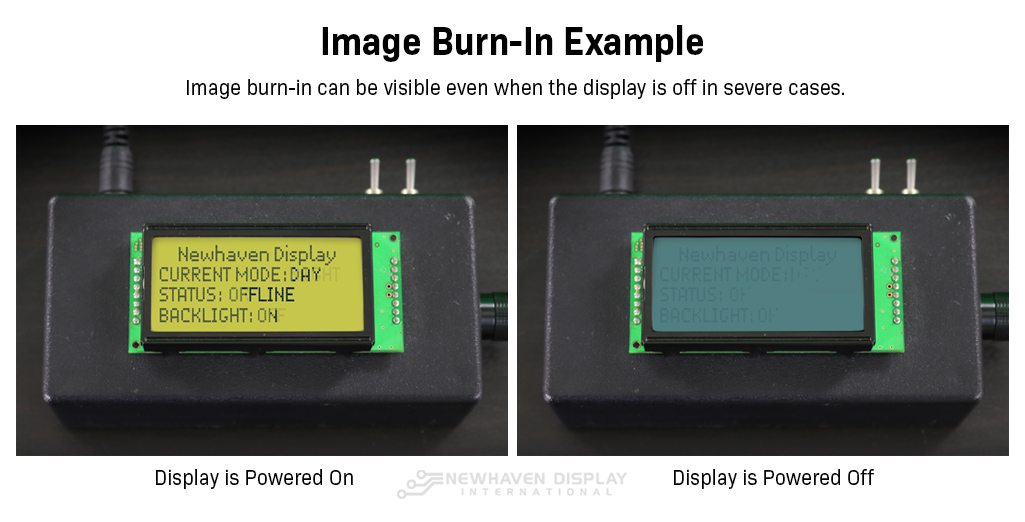 Exemplo de burn-in de imagem no LCD.
Exemplo de burn-in de imagem no LCD.
Burn-In vs Retenção de Imagem
Chances are you've encountered image burn-in and image retention before, but you didn't know which one you were seeing. They both have the same visual effects, so it's easy to mistake them for each other, but there's one key difference: image retention is temporary, and image burn-in is permanent.
We've seen many misleading articles, videos, and guides about "fixing" image burn-in or removing it from a display. Image burn-in is completely irreversible once it occurs on your display screen.
Na maioria das vezes, estes guias explicam como funciona a retenção de imagem e como se pode acelerar o seu processo de recuperação. Queremos esclarecer qualquer confusão que possa ter acerca da queima e retenção de imagem em ecrãs LCD e OLED.
Retenção de imagem
A retenção de imagem, também conhecida como fantasma ou persistência de imagem, é o efeito temporário das imagens permanecerem visíveis nos LCDs ou OLEDs durante um curto período, normalmente de alguns segundos.
How to tell the difference between image retention and screen burn-in?
Se as imagens desaparecerem após um curto período de tempo, está a lidar com a retenção temporária de imagem. Se as imagens permanecerem permanentemente, está a lidar com burn-in de imagem.
Image retention doesn't require any intervention from the user to make it go away – it'll do that by itself. Retention will often occur before burn-in does on newer display technology like our TFTs and our new IPS displays.
Relacionado: O que é uma exposição IPS?
Image retention will fade away, but there are some tips you can use to speed up the process. Simple actions like using a screen saver, cycling various graphics on the screen to exercise the pixels, and powering off the display whenever possible will help clear the image retention on your display.
Estes são os mesmos truques que verá anunciados como "cura" para a queima da imagem, mas não se deixe enganar. Não há solução para o "burn-in", apenas formas de o prolongar de acontecer.
Antes de assumir que o seu ecrã está danificado, experimente estas dicas e aguarde para ver se é apenas retenção de imagem. A retenção de imagem é uma ocorrência inofensiva e comum em muitos ecrãs.
What Causes Screen Burn-in?
Screen burn-in is caused by screen pixels that stay activated in a static position for long periods of time. Think of a TV in a lobby or waiting area that's always playing the same news channel. The news channel footer and logo get burned into the screen permanently, even when you change the channel.
As causas comuns de "burn-in" da exposição incluem: imagens estáticas, mensagens, logótipos, e ícones.
Em telemóveis, por exemplo, a queima de imagem pode ser causada pela posição estática permanente da bateria, wifi e ícones de sinal de serviço.
Quando os pixels LCD ou OLED permanecem activados numa posição estática, acabarão por ficar "presos" nessa posição. Quando isto acontece, notar-se-á uma imagem desvanecida e teimosa que persiste no ecrã.
Burn-in em ecrãs LCD e OLED
O resultado do burn-in parece o mesmo em todos os tipos de ecrã, mas a forma como ocorre nos LCDs e OLEDs é ligeiramente diferente.
Relacionado: Diferenças entre OLEDs e LCDs
Como ocorre o "burn-in" nos LCDs
Depois de mostrar uma imagem estática durante longos períodos de tempo, os cristais num ecrã de cristais líquidos tornam-se mais fracos para se moverem, e têm mais dificuldade em passar da posição totalmente "ON" para a posição totalmente "OFF
Quando os pixels não conseguem activar ou desactivar completamente, resulta em imagens desbotadas que não se apagam do ecrã. Isto é comum em aplicações que utilizam LCDs de caracteres onde os caracteres alfanuméricos são actualizados com menos frequência.
No exemplo abaixo, notará uma impressão permanente desbotada do texto deixado no ecrã LCD após o ecrã ter sido desligado.
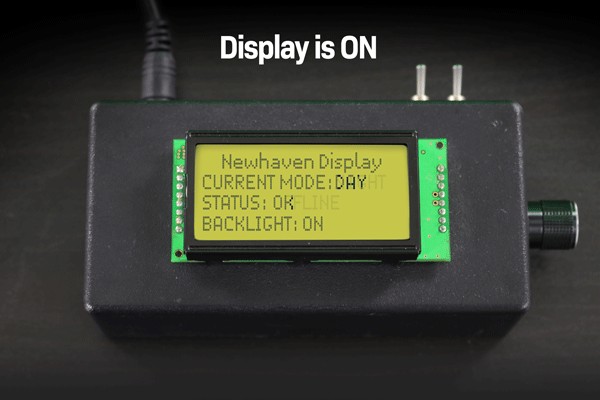 Exemplo de burn-in de imagem LCD de caracteres quando o visor está ligado e desligado.
Exemplo de burn-in de imagem LCD de caracteres quando o visor está ligado e desligado.
Como ocorre o burn-in nos OLEDs
Os OLED são únicos porque não precisam de uma luz de fundo para se iluminarem. Cada pixel no visor é um LED auto-iluminante, pelo que geram a sua própria luz. No entanto, os pixéis perdem inevitavelmente o seu brilho ao longo do tempo. Quanto mais tempo um píxel OLED for iluminado, mais escuro aparecerá ao lado de píxeis menos utilizados.
Se uma imagem estática permanecer num visor OLED o tempo suficiente, os pixels deixarão uma sombra para trás da imagem anterior, mesmo quando o visor mostrar algo completamente diferente.
Veja como o texto "Altura Dupla" é queimado no OLED no exemplo abaixo.
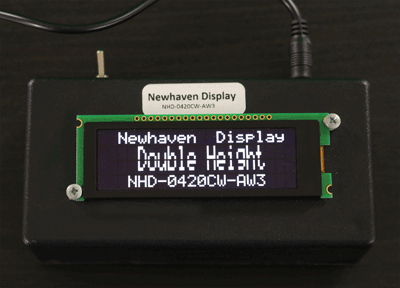 Exemplo de burn-in de imagem OLED.
Exemplo de burn-in de imagem OLED.
Lembre-se: Não há forma de remover ou reduzir o burn-in após a sua ocorrência. Se uma imagem teimosa persistir por longos períodos ou após reiniciar a sua exibição, é provável que esteja a lidar com o "burn-in" da imagem.
Early Signs of LCD Screen Burn
LCDs don’t suffer from permanent burn-ins like OLEDs, but they can experience a temporary form known as image persistence. This occurs when a static image lingers faintly on the display even after the display content changes. Here are the early signs to watch for:
-
Ghosting or faint remnants of a previous image: If you can still see a shadow of a menu bar, logo, or other static content after switching screens, this is an indication of image retention.
-
Slow response time when transitioning images: If pixels take longer to refresh or adjust to new content, especially in high-contrast areas, your LCD may be experiencing early image persistence.
-
Color distortion in affected areas: Some parts of the display may appear slightly discolored or "washed out" after extended exposure to static content.
-
Variations across LCD types: IPS (In-Plane Switching) panels, commonly used for wide-viewing angles, are less prone to persistence than TN (Twisted Nematic) panels, which have faster response times but may exhibit minor retention effects.
If detected early, image persistence can be reversed by turning off the display or using a display refresh function. However, extended exposure to static content increases the risk of more stubborn retention.
LCD Applications Prone to Burn
While LCDs are less susceptible to permanent burn-in than OLEDs, certain industries rely on displays that frequently show static images, making them more prone to image persistence.
-
Medical Equipment Displays: Patient monitoring systems, diagnostic screens, and imaging devices often show static vital signs, graphs, or interface elements for extended periods, increasing the likelihood of image retention.
-
Industrial Control Panels: Factory automation screens, process control monitors, and instrumentation panels display static data, such as readouts and system statuses, for long durations.
-
Point-of-Sale (POS) Systems: Retail checkout displays and kiosks frequently show the same user interface for hours, leading to uneven pixel wear.
-
Automotive and Marine Displays: Navigation systems, dashboard readouts, and infotainment screens may hold the same map or gauge interface for long periods, causing temporary retention.
-
Test and Measurement Devices: Oscilloscopes, spectrum analyzers, and other laboratory instruments often feature fixed graphical elements, which can contribute to image persistence over time.
Newhaven Display’s TFT LCD modules are engineered with pixel-shifting technology, optimized brightness control, and advanced refresh techniques to minimize image retention. These design enhancements help extend the longevity and reliability of displays in mission-critical applications.
Early Signs of OLED Screen Burn
Unlike LCDs, OLED displays are more vulnerable to permanent burn-in due to their self-emissive pixels, which can degrade at different rates over time. Understanding the conditions that accelerate this process is essential for engineers designing long-lifespan products. Signs of OLED burn-in include:
-
Persistent ghost images: Static elements, such as logos or user interface (UI) components, remain visible even after switching displays, indicating pixel wear.
-
Uneven brightness levels: Frequently used areas may appear dimmer due to pixel aging, where some pixels degrade faster than others.
-
Color shifting or distortion: Affected regions may develop color imbalances, such as a reddish, yellowish, or bluish tint where burn-in has occurred.
-
Noticeable differences in high-contrast areas: Burn-in is most apparent where bright elements frequently overlay darker backgrounds, causing uneven luminance.
OLED Applications Prone to Burn
OLED displays offer vibrant colors and high contrast, making them ideal for many applications. However, certain use cases increase the likelihood of burn-in:
-
Medical and Diagnostic Displays: Patient monitoring systems and imaging equipment often maintain static readings and graphical elements.
-
Industrial and Automation Interfaces: Factory control displays frequently show persistent navigation menus and system statuses.
-
Handheld and Portable Devices: OLED-based test equipment, communication devices, and specialized tools often display static UI components.
-
Automotive and Aerospace Displays: Digital dashboards, heads-up displays (HUDs), and in-flight entertainment screens maintain fixed navigation elements and branding.
-
Retail and Commercial Signage: OLED advertising displays that feature static logos, pricing, or promotional graphics are at higher risk.
To mitigate OLED burn-in, Newhaven Display designs its OLED modules with pixel wear-leveling, automatic brightness adjustment, and built-in display refresh cycles. These features help extend the operational life of OLED displays used in high-contrast applications.
How to Test for Screen Burn
Detecting screen burn early can help prevent further pixel degradation. Here are a few methods to test for screen burn on LCD and OLED displays:
-
Full-Screen Color Tests: Displaying a solid color background (such as white, red, green, or blue) at full brightness can reveal ghost images or uneven pixel wear.
-
Gradient and Gray Screen Tests: Viewing a gradient pattern or a uniform gray background can help detect subtle color shifts, which may indicate early signs of burn-in.
-
Switching Between High-Contrast Images: Quickly alternating between bright and dark images can make burn-in effects more noticeable, especially in frequently used areas of the display.
-
Using Specialized Burn-in Test Tools: Some diagnostic applications generate test patterns designed to highlight persistent image retention or OLED burn-in.
If mild image retention is detected, running a pixel refresh cycle, adjusting brightness levels, or using a screen saver can help reduce visibility. However, permanent burn-in on OLED displays cannot be reversed, making proactive prevention the best approach.
Ways to Mitigate/Avoid Screen Burn-in
Mesmo os ecrãs mais avançados experimentarão o burn-in em algum momento, mas há algumas acções simples que pode tomar para prolongar a vida útil do seu ecrã antes do burn-in ocorrer. Com as práticas adequadas, pode obter anos de desempenho excepcional do seu ecrã sem quaisquer efeitos de burn-in.
How to avoid screen burn-in
- Desligar o visor quando não estiver a ser utilizado
- Usar um protector de ecrã
- Exercício dos pixels (efeito de rotação ou scroll)
- Baixar a luminosidade ou contraste do ecrã
Relacionado: Como Limpar um Ecrã Electrónico
Sabia que... Os protectores de ecrã derivam o seu nome do seu propósito original, que era um método activo de tentativa de mitigar o "burn-in" do ecrã.
Desligar o visor quando não estiver a ser utilizado
Sabemos que, em alguns casos, necessitará de uma exibição "always-ON", ou a sua exibição terá de permanecer ON por períodos prolongados.
Se alguma vez tiver a oportunidade, execute um ciclo completo de energia no seu ecrã. Isto irá redefinir os pixels e ajudar a evitar o burn-in.
Se um ciclo de energia não for uma opção, pode usar o comando ON/OFF do visor para desligar o visor. Em alternativa, pode colocar o visor em modo de repouso, mantendo os dados do visor em RAM.
Usar um protector de ecrã
Um protector de ecrã é uma boa alternativa se não conseguir desligar a sua exibição. Para ecrãs que não precisam de estar sempre ligados, é útil deixar o ecrã descansar quando não está a ser utilizado.
Um protector de ecrã ou modo de repouso permite um arranque rápido em comparação com o desligar e voltar a ligar totalmente o dispositivo.
Exercício dos pixels
Ponha esses pixels em movimento! Quanto mais tempo um pixel permanece activado numa posição estática, mais perto fica de ser queimado. Pode exercitar os pixéis do seu ecrã com texto em rolagem, imagens em movimento, ou mudança de cores.
Esta técnica é muito semelhante à rotação dos pneus do seu carro. O objectivo é distribuir o desgaste por toda a exposição uniformemente.
Baixar a luminosidade ou contraste do ecrã
Diminuir o brilho do ecrã sempre que possível. Mais iluminação (brilho) requer mais corrente, o que reduz o tempo de vida útil dos LED.
Para um visor OLED, a diminuição do contraste irá diminuir o brilho e reduzir a taxa de queima da imagem. Mais iluminação (brilho) requer mais corrente, o que reduz a duração dos píxeis OLED.
Para um ecrã LCD, a redução do contraste colocará menos stress nos cristais líquidos e ajudará a reduzir a taxa de pixels a ficarem fracos, ou a aderirem.
Tudo sobre LCD e OLED Burn-in - [Vídeo]
Find more helpful videos like this on our YouTube channel.
Conclusão
Lembre-se que o burn-in de imagem não é reversível e não pode ser fixado uma vez que acontece. Quer seja um efeito de rolagem, rotação de pixels, utilização de um protector de ecrã, ou desligar o ecrã quando não está a ser utilizado, é essencial estabelecer medidas preventivas de "burn-in" de imagem para ajudar a prolongar a vida útil do seu ecrã.
Últimos posts no Blog
-
Nits vs Lumens vs Luminance: Key Differences Explained
While looking at some of the many light-emitting devices, such as televisions, LCDs, or light bulbs, …Nov 21st 2025 -
Exploring Display Types: TFT, LCD, OLED, & VFD
Every product that incorporates a display relies on the right technology to meet performance and rel …Oct 20th 2025 -
A Guide to LCD Resolutions & Aspect Ratios
Resolution and aspect ratio play a central role in how a display performs once integrated into a pro …Oct 16th 2025

